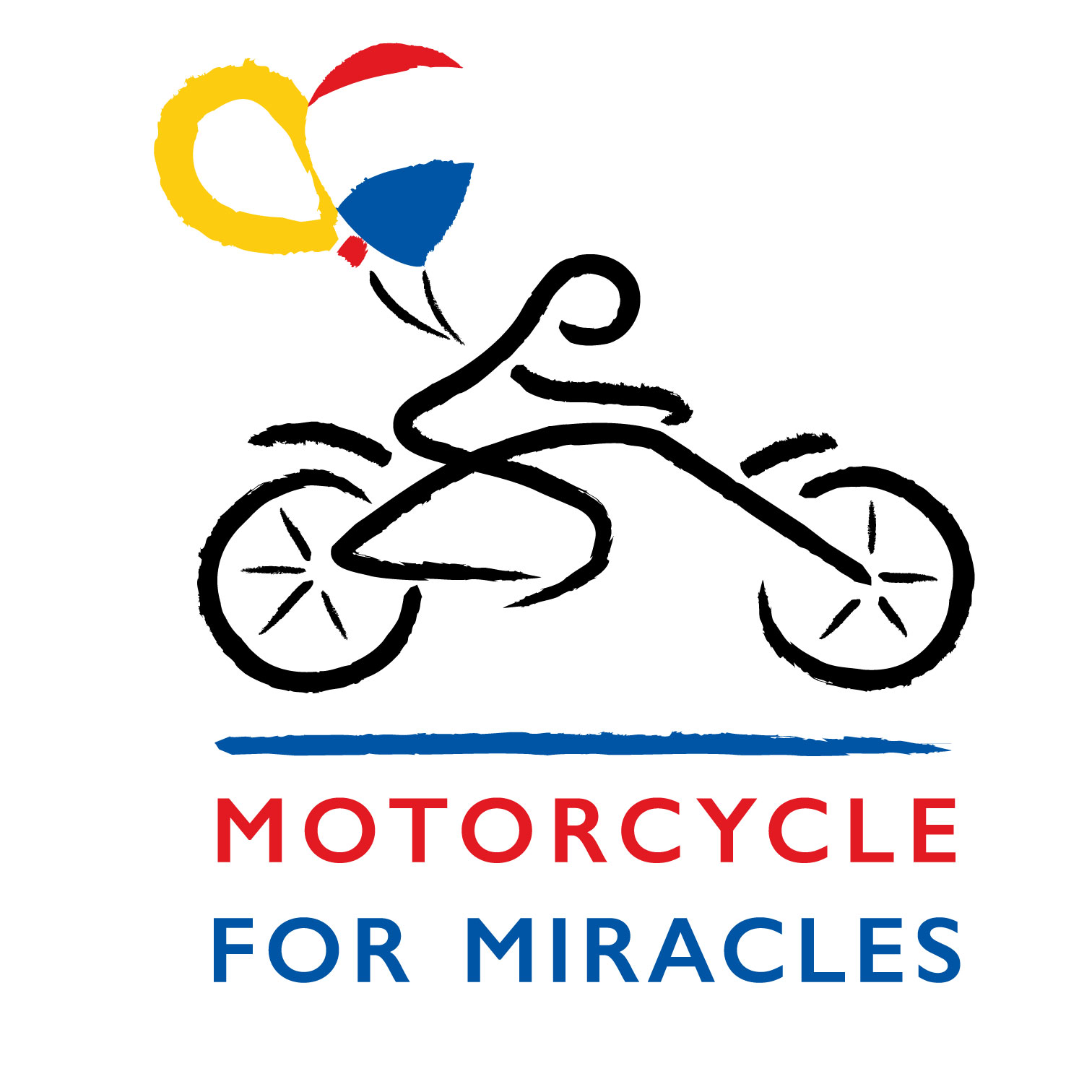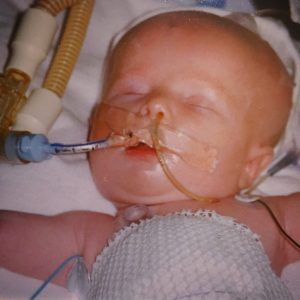 Tonight, once again, I am remembering. It’s Alyssa Rae’s birthday week, and I’m sharing her life – and as an extension, our lives, in hopes that it will reach you. I pray that 20 years after her arrival, Alyssa’s life story can inspire reflection and giving. It’s all for a fundraising flash mob of remembrance, love, and hope. Please don’t hesitate to spread the word, let’s build some momentum toward her November 17th birthday so together we can raise as much as possible, in increments of $20.
Tonight, once again, I am remembering. It’s Alyssa Rae’s birthday week, and I’m sharing her life – and as an extension, our lives, in hopes that it will reach you. I pray that 20 years after her arrival, Alyssa’s life story can inspire reflection and giving. It’s all for a fundraising flash mob of remembrance, love, and hope. Please don’t hesitate to spread the word, let’s build some momentum toward her November 17th birthday so together we can raise as much as possible, in increments of $20.
This is Post 2 of 4. If you are new to this thread of posts, for a better understanding, start with Post 1, where I describe the pregnancy and birth of Alyssa.
For four long days after Alyssa was born and transported to SickKids Hospital, I stayed checked in at Mt. Sinai Hospital for C-section recovery, but I was only there to sleep and let the nurses do their charting. Otherwise, Bruce helped me throw a bathrobe over my hospital gown and boldly broke me outta there by wheelchair. After sleeping on a lumpy couch in some kind soul’s office, or tucking inconspicuously into a closet for the night, he would dash back to Mt. Sinai, I’d hop on, and he’d catch me up on what the morning nurse had reported as he sped me across the tunnel and up to the 2nd floor, NICU at SickKids Hospital.
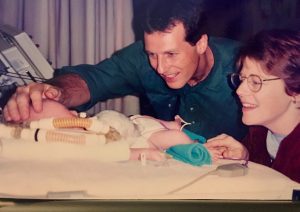 Alyssa was in a typical NICU room, which was divided into 6 stations. Six babies, usually in incubator-type isolettes, could be monitored and cared for by 6-10 highly trained NICU nurses in this room. Thankfully there were a couple of empty areas at the time of Alyssa’s arrival. Alyssa was at the far left, close to a large window, and we were happy she would have tons of natural light by day and a view of the moon and stars at night.
Alyssa was in a typical NICU room, which was divided into 6 stations. Six babies, usually in incubator-type isolettes, could be monitored and cared for by 6-10 highly trained NICU nurses in this room. Thankfully there were a couple of empty areas at the time of Alyssa’s arrival. Alyssa was at the far left, close to a large window, and we were happy she would have tons of natural light by day and a view of the moon and stars at night.
Spending the day with Alyssa was mesmerizing. The hours felt like minutes. We were getting to know her and she was a beautiful baby, with blonde hair and the kind of deep blue eyes you’d more likely see in some wizened old storyteller than in a fresh infant. Compared to the other babies who were mostly extreme preemies, she was huge at 6 lbs 2 ounces. We could have happily just perched there holding her fingers, talking and singing to her. There was a lot to do and learn though. Thankfully, the nurses recognized that we were hands-on parents, and they were happy to teach us what all the tubes and machines did, so we could alert them to anything that looked concerning. The “leads” that went to the monitors had 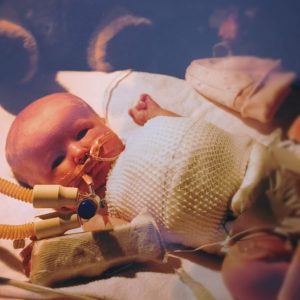 a certain way to be rearranged for different procedures, like changing the dressing on her omphalocele and changing her diapers. The monitors became something we relied on to tell us whether she was uncomfortable or upset. When her oxygen saturation was dropping or her heart rate was spiking, it was hard for me to stay calm. The monitors were Alyssa’s only voice, as she had no other way to express the terrible pain of getting her heel pricked for the 12th time that day, or having her lungs suctioned for the 3rd time that hour.
a certain way to be rearranged for different procedures, like changing the dressing on her omphalocele and changing her diapers. The monitors became something we relied on to tell us whether she was uncomfortable or upset. When her oxygen saturation was dropping or her heart rate was spiking, it was hard for me to stay calm. The monitors were Alyssa’s only voice, as she had no other way to express the terrible pain of getting her heel pricked for the 12th time that day, or having her lungs suctioned for the 3rd time that hour.
We were also engaged in her care plan, and keeping track of various specialists, tests and surgeries. We were welcomed to stay at her side when physicians made their rounds. Interns were always at the periphery, taking notes, and occasionally asking questions. We had long since given up any idea of privacy or shyness. We were fierce advocates for anything and everything that could any way help Alyssa, and we figured if an intern from overseas asked something no one else had thought of, well that could be a lifesaving breakthrough. We were open to it all. The first major repair was booked for November 20th, when she was just 3 days old. Omphaloceles were nothing unusual to the surgeon who was scheduled for Alyssa’s “closing” surgery and it was upon meeting Dr. Ein when it started to sink in, what an extraordinary hospital we had lucked into, with SickKids. Bruce described him perfectly in a letter updating friends and family, after our first week with Alyssa:
Dr. Sigmund Ein, he with the ancient crackled white shoes and the hospital badge with his photo showing a cut-out of Hulk Hogan: this man operated on our baby within her first few days of life and managed to tuck in most of her liver and, more importantly, cover her heart with skin. He basically took Alyssa out for a test drive to see what she’d do. She “did” just fine. A confident man, that Dr. Ein. As they were wheeling Alyssa toward the surgery room, I said to a nurse: “Excuse me, I see that no one witnessed my signature on the surgical consent form.” The nurse smiled and called to Dr. Ein, ahead of us in the hall. “Dr. Ein, Daddy Johnson says that you didn’t witness his signature.” The good doctor stopped at the door, pulled his mask down and said to me, smiling: “God is my witness.” The kind of confidence you want to see in the man who, forty minutes later, would be holding your daughter’s tiny beating heart in his hand. Alyssa is recovering well now and they plan to start weaning her off of the respirator tomorrow. This may be a slow and painful process but we have every confidence she can do it!
As the days rolled on, a tiny spark of hope that Alyssa could survive started to kindle. We were told by Dr. Ein to be cautiously optimistic. Music to our ears. She was being fed through an NG tube and we were so relieved to see her first poops. Her digestive system was functioning! Dr. Ein humoured our questions about how she would play sports, and explained in detail, the process of gradually tucking all the organs back in and closing an omphalocele.
If this was to be a long-term stay, there was no way we could afford a downtown hotel, so volunteers in the atrium gave us the number for the nearby Ronald McDonald House. This was a residence about 5 or 6 long blocks from SickKids, where for a minimal ($15 at the time) charge, parents and siblings of young patients could feel at home away from home. What a stroke of luck that they had a room for us and we could come the next day. There was a phone for local calls in the room, and long distance in the hallway, and a nice shower, and a super comfy bed. We were given a cupboard and part of a fridge if we wanted to stock up. Occasionally, volunteers, pro athletes and celebrities would stock up the communal kitchen, with giant cheesy lasagnas and tins of fresh-baked cookies. We were so grateful! It was November, with all its brisk and blustery weather, and the walk worked wonders to clear our minds and energize us for the day ahead. We would stop and grab a coffee, then high tail it up to Alyssa’s room from morning til they booted us out at bedtime later at night. The night shift nurses knew that with any change at all with Alyssa, to call us. We weren’t sleeping well anyway and were always hungry for updates at the late-night shift change. When friends would visit and bring a snack or meal from the Atrium, we would reluctantly retreat to the parent break room. Ah, the old parent break room. I think it’s gone now. It was a rectangular room with one door, a couple of phones, and upright chairs. Imagine no cell phones, you’re facing each other in stark lighting and listening to each other’s heartbreaking stories as they fill in loved ones from afar. Sounds terrible, but it actually brought us together and soon enough, we were learning each other’s babies’ names, complications, and outlooks. There were very very sick preemies, babies in need of organ transplants, triplets with chromosomal challenges. I started to feel relatively lucky because Alyssa’s prognosis was looking better and better every day. And although a transient, ever-changing group, we started to feel that for brief moments we could support each other, cry with each other, and celebrate each other’s milestones and victories.
This was at the gentle, lofty height of the roller coaster of Alyssa’s 20 days. Bruce and I leaned on each other and kept a positive attitude, as if this were just another mountain, even if we had to push our bikes instead of easily ride them. I had my Mom with me a lot, too, which was a great comfort. She had a cassette player for us, and a couple of lullaby tapes and some folk music from Minnesota. We carried it with us to a vacant office so I could pump some breast milk in private. The doctor had said I could finally provide breast milk for Alyssa to be fed through her NG tube, so I should collect it in lab jars, write my name and date on it and store it in the fridge near the nursing station. I would need to buy my own pump which was a huge expense – $300! We didn’t have $300. So the world’s greatest social worker took up our cause and wrote to companies on our behalf, for a discount or donation. She did it! She got us an amazing pump, with all the bells and whistles. We would be able to keep it and we imagined how handy it was going to be when we brought Alyssa home, to be able to pump and leave a bottle for the babysitter. We were starting to dream!
It was so nice to welcome visitors. Aunt Cathy was always there, even when we couldn’t be, she would sit with Alyssa before her workday started at nearby Toronto General Hospital. She left us adorable notes as if written by Alyssa and would have all the nurses oohing and ahhing at her latest finds from Baby Gap and Gymboree. Blanket sets with matching hats, the cutest outfits. It was a bit of normalcy, for our sweet girl to be spoiled by her Aunt, and we appreciated those gestures so much. We appreciated all the gifts from friends and were allowed to decorate Alyssa’s area with family photos, homemade cards, a dream catcher, a teddy bear with a “womb” heartbeat, personalized Christmas ornaments, mini angels. There are photos of visits from our parents, siblings, nieces, nephews and best friends that we will always cherish. Our family doctors Myrna and Amar came to meet her and help us understand the next steps, and colleagues from RE/MAX of Wasaga Beach blew us away with a wonderful photo album, filled with best wishes and by taking up a collection so that we could stress a little less about missing work and covering all the living expenses. There were a couple of gifts of money that left us speechless. We’ll never forget when one couple came to see us and quietly slipped us a hundred dollar bill, and another acquaintance mailed us a cheque for $100 in the hopes that we’d use it for a massage or some healing indulgence. We were gobsmacked. Those donations of kindness and generosity were so impactful, we remember every single gesture. We learned something about giving then, by being at the receiving end. We learned that people who need the help the most, don’t even realize it at the time.
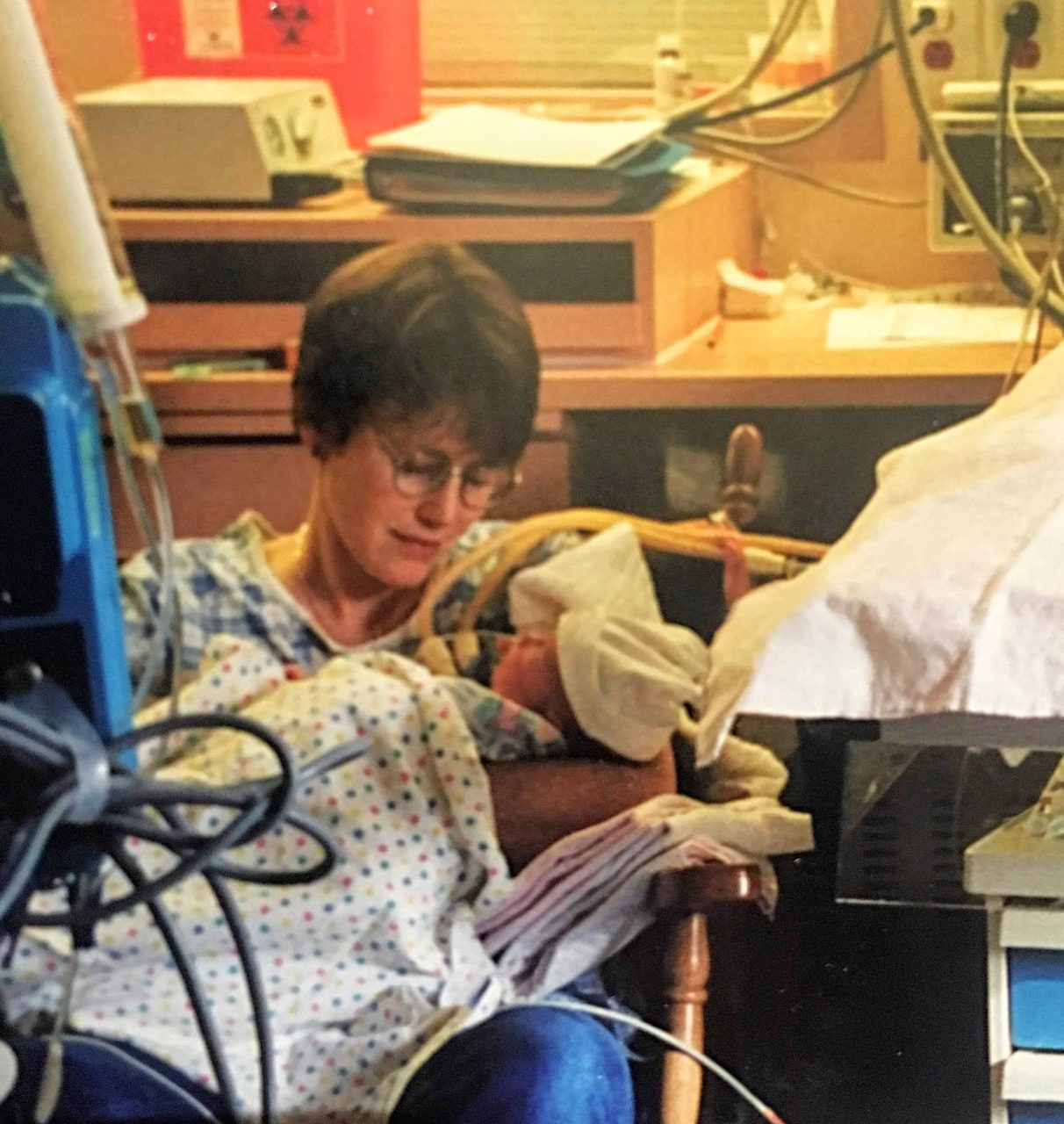 When Alyssa was 8 days old, and nurse Judy was on (one of our favourites, she loved Alyssa so dearly and we loved her back) we were given our first chance to hold our baby. For over two hours, we took turns holding and rocking her for the first of very few times. She was on the ventilator so we couldn’t hold her against our chests. How I wished I could hold her tight, with her cheek to mine. But this was heaven, and her oxygen sats showed that she was melting into the moment as well. The next day, although she was retaining fluid and really puffy-faced, the respiratory team turned down her ventilator a notch or two. The nursing staff poured their hearts into caring for her and involving us. The smallest gestures of kindness from these rockstar nurses would make us blubber, we were so emotionally charged. Seeing a nurse kiss Alyssa’s little foot after a needle poke, arriving to see the night nurse had cut her bandage into the shape of a heart, the trust they had in as parents, to do dressing changes and diaper changes without supervision. Seriously if you are a NICU nurse, heck if you know a NICU nurse or even just spot one anytime anywhere, give them a hug and all the respect you can express. Anyway, these nurses infused us with hope: maybe we’d see if those little lungs had any get-up and go on their own!
When Alyssa was 8 days old, and nurse Judy was on (one of our favourites, she loved Alyssa so dearly and we loved her back) we were given our first chance to hold our baby. For over two hours, we took turns holding and rocking her for the first of very few times. She was on the ventilator so we couldn’t hold her against our chests. How I wished I could hold her tight, with her cheek to mine. But this was heaven, and her oxygen sats showed that she was melting into the moment as well. The next day, although she was retaining fluid and really puffy-faced, the respiratory team turned down her ventilator a notch or two. The nursing staff poured their hearts into caring for her and involving us. The smallest gestures of kindness from these rockstar nurses would make us blubber, we were so emotionally charged. Seeing a nurse kiss Alyssa’s little foot after a needle poke, arriving to see the night nurse had cut her bandage into the shape of a heart, the trust they had in as parents, to do dressing changes and diaper changes without supervision. Seriously if you are a NICU nurse, heck if you know a NICU nurse or even just spot one anytime anywhere, give them a hug and all the respect you can express. Anyway, these nurses infused us with hope: maybe we’d see if those little lungs had any get-up and go on their own!
Sadly, these hopeful highlights were not to last. The next day, Alyssa underwent more testing. Ultrasound, ECHO, blood tests. There were discussions about blood type and a blood transfusion, about Alyssa perhaps receiving blood from Bruce, who was also O+ type. The ventilator could not be sustained at a lower level and her lungs needed more and more suctioning to stay clear. Given the discomfort of these procedures, tests and just being stressed, the doctors decided she should be given morphine to calm her and reduce her pain. She rarely opened her eyes now.
Then came the saddest day: November 29th. We say that December 6th was the saddest day, but when I really think about it, November 29th was just as life-shattering. While Bruce and I were with her, and she was being suctioned yet again, the day turned very very bad. It pains me to return to this moment and I struggle with how to fully describe it. Or even if I should fully describe it. I mean, what is the benefit to anyone, to know what happened next? Alyssa turned blue. The nurse, who of course was now and forevermore my least favourite, started bagging her and pushing alarms. Code blue. RT. Stat. The world stopped. Can you remember where you were, November 29, 1998? I think about that. RIGHT NOW is somebody’s November 29th. My heart is in my throat at the thought.
The team of respiratory therapists flew in with their cart full of meds and tanks and clipboards and somebody took charge. Alyssa was being breathed and still, her blood oxygen saturations were disastrous…this was full respiratory distress. She endured nearly 30 minutes of super-low blood oxygen while the RT team got her cleared, but now she was only breathing with the ventilator, which was turned up to provide 100% oxygen, so she wouldn’t have to struggle or try to breathe on her own that day.
That crash was followed by the start of the seizures. I don’t remember if they were always at night and I didn’t see them, or if I just blocked them out, but I don’t remember witnessing them. Still, they were severe and frequent enough to call for yet more testing. EEG. Head ultrasound. ECHO. Chest X-ray. At 2 weeks old, doctors decided she would need “the oscillator” which sounded like a torture device to me, and from what I understood, once a baby was on this more extreme ventilator, it would be much harder to wean off from it. Another CT scan… and when all results were in and confirmed with national and international pediatric expertise, it was time for what we dubbed “The Talk.”
As Bruce described later in an email update, the great fear of brain damage was realized by the CT scan and other tests, which revealed not just that there was an irreparable injury to her white and grey matter but also that her brain was small for her skull size and that her brain stem had severe problems as well. If it were just the omphalocele, she could make it, the surgeons told us. If her lungs had developed a bit more, she might have had a chance, the neonatologists told us. But her hypoplastic lungs, an omphalocele containing liver and intestines, her heart being outside her chest cavity, all that plus a damaged brain with a brain stem abnormality causing the horrific seizures…it all pointed to a life of severe debilitation.
We wanted a second opinion and Dr. Moore, Alyssa’s earlier neonatologist, concurred with Dr. Whyte. And so did Dr. Pearlman and every NICU nurse we spoke to. Still we were wavering. This was our daughter’s life we were discussing. And then our Dr. Ein came along Thursday evening and took us into the Parent Care room. The bad news room. The man who had just a few days before saved Alyssa’s life with his great surgical skill, was now recommending that we choose the hardest path of our lives so that Alyssa could have the easiest path: to let them disconnect her from the ventilator. Dr. Ein, he of the take-no-prisoners school of surgery…told us that as hard as it was, if she were “an Ein baby” he would let her go. No question. And then his eyes filled with tears and he left the room.
~Bruce
It is an impossible question, isn’t it? Would we be condemning her to a life of pain if we lacked the courage to disconnect her from the machine that breathed for her? What if? What if? I wonder if tonight, there are parents looking at a DNR form, having decided that the most loving action they can take is to take no more heroic actions to keep their child alive. I can only hope and pray that they too are surrounded by loved ones, are supported by a few hundred years of combined pediatric doctor and nurse experience and can open up to the painful reality that not every life must be sustained to be impactful. Even a 20-day life is a miracle, or miracle enough. Miracle enough to never be forgotten. As much a miracle as any of us can be, pebbles dropping in a pond, sending out ripples so enduring that even they can even make the world a better place. There were no quiet ponds that night, as freezing rain pelted the windows at SickKids Hospital. It was December 3rd, 1998, and we signed the DNR.
To read more, see Part 3, Saying Goodbye and Remembering Alyssa Rae
To view the photos in the gallery below, click on the first one and scroll through at full size.
